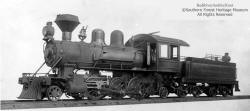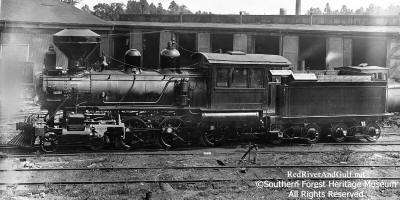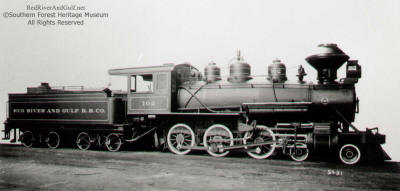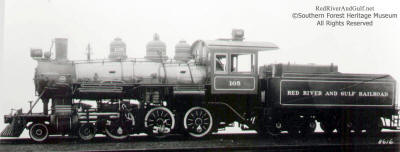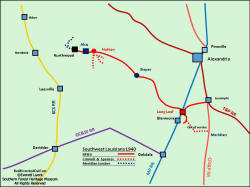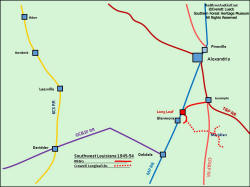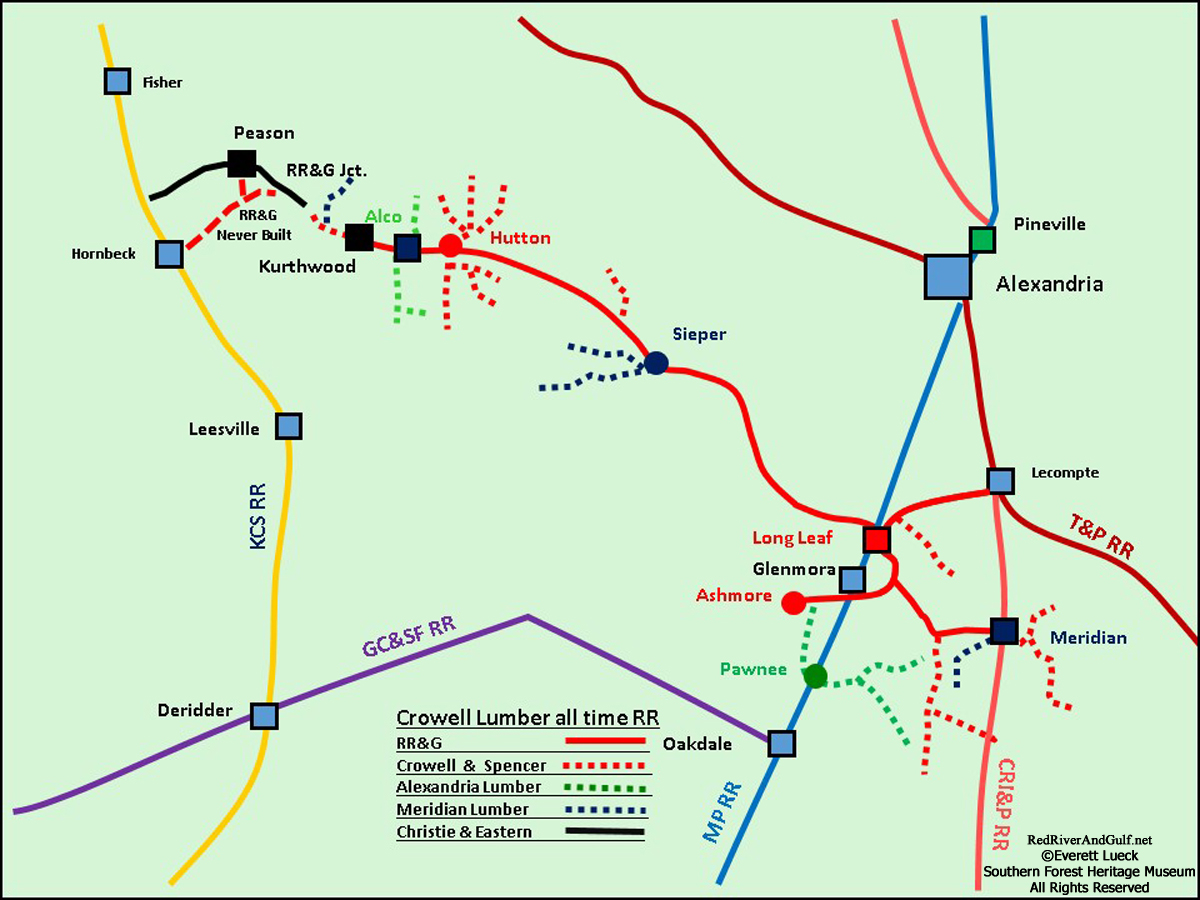|
|
|
|
|
|
|
The Red River & Gulf Railroad was born in 1905. Its parents were the Crowell & Spencer Lumber Company log tram and the stockholders of the Lumber Company of Long Leaf, Louisiana. Its "godfather" was George Gould, son of rail builder and rail baron, Jay Gould.
In 1895 Crowell & Spencer started construction of its first tramway from Long Leaf, building west and southwest to reach the first timber that the company purchased. By 1904, most of the timber along this line had been harvested and Crowell & Spencer looked toward timber that they had purchased since 1900. Most of this timber was located east of Long Leaf, both north and south of Spring Creek and Cocodrie Lake. |
|
|
1907
RR&G #1 |
But for George Gould, C&SL would have simply extended the tram road into the new timber and that would have been it. However, Gould was trying to complete his fatherís dream of a true transcontinental railroad under a single management, and the Crowell railroad connection at Long Leaf was part of the plan. Gould raised rates on everything that his railroads hauled to raise money for the construction of the final link in the plan, the Western Pacific Railroad. The Crowell response was to incorporate and build their own common carrier railroad, the Red River & Gulf , to connect Long Leaf with the other railroads that ran south and east from Alexandria. This would provide increased car supply (always a problem) and better rates on Crowell lumber products as well as a portion of the rate division on handling the lumber products. Originally, the railroad was platted to run 12 miles east from Long Leaf, to Lecompte where it was to connect with the Texas & Pacific and Southern Pacific railroads, continuing on an additional 8 miles to a junction with the Louisiana & Arkansas Railroad at the station of Roxana.
|
|
Built by Crowell & Spencer during the second half of 1905, the railroad reached a junction with the Texas & Pacific at Lecompte in December of that year. By the time the railroad reached this point, the Chicago, Rock Island and Pacific was already building south from Alexandria and would pass through Lecompte. Satisfied with 3 additional interchange partners, the railroad was stopped at Lecompte and never constructed further east. In February 1906, Crowell & Spencer transferred the completed railroad to the Red River & Gulf RR. At the same time, the Rock Island reached Lecompte and connected with the RR&G. The Rock immediately reached an agreement to run its trains over the RR&G to the gravel pits at Forest Hill in order to obtain ballast for additional construction in Louisiana. By the end of 1907, the payments by the Rock Island for the ballast trains paid for almost half the cost of building the RR&G.
The railroad was equipped with a single, small 45 ton, Lima 2-6-2 #1, a combination freight and passenger car, and 4 flat cars as a roster of equipment according to testimony before the ICC in 1910 by J. Stamps Crowell, its operating vice president. He also testified that the railroad was constructed with a mix of 35#, 45# and 50# rail and that Crowell & Spencer log trains operated over the first 6 miles east from Long Leaf in order to access the new portions of the Crowell tram road in that area. In addition, based on its Official Guide entries, the RR&G also operated west over the Crowell tram road another 9 miles to the Crowell logging camp of Ashmore.
|
|
|
By the end of 1912, Crowell logging operations in central Louisiana began to undergo great changes. In order to efficiently log the amount of timber that Crowell & Spencer had acquired, a second company, the Meridian Lumber Company, was incorporated and a second sawmill and town were built at Meridian, Louisiana. A new station on the Rock Island, 12 miles southeast of Long Leaf, and 11 miles south of Lecompte was also completed. The RR&G extended freight service to Meridian over the Crowell & Spencer and Meridian Lumber tramways by the end of 1913. At the same time, service to Ashmore was no longer offered, probably because the rails to Ashmore had been lifted and reused on the tram roads. |
RR&G in 1916 |
|
RR&G #101
RR&G #102
RR&G #104
|
During 1914, the Louisiana Sawmill Co. began construction of a large sawmill on the southeast side of Glenmora at Bolton, 3 miles south of Long Leaf and 2 miles from Louisiana Junction, where the former tram line to Ashmore had joined the tram road to Meridian. Again, Crowell & Spencer built this 2 mile branch turning over operation of the track to the RR&G in January 1915. This expansion caused two changes to the RR&G. First, the entire railroad from Louisiana Jct. to Lecompte was re-laid with brand new 60# steel from Tennessee Steel Co. This rail is still in place on the RR&G today. Second, Meridian 4-6-0 #101 was traded for RR&G 2-6-2 #1 as the 4-6-0 was better suited for hauling main line trains. At the same time, the RR&G ordered the first of four 4-6-0ís from Baldwin. #102 entered service on the RR&G in July, 1915, occasionally spelled by new Crowell 2-6-2 #303 when the traffic could not be handled by only two engines.
Also in 1915, the RR&G entertained the idea of operating over the Crowell tram 14 additional miles south to Pine Prairie. For several years maps in the Official Guide showed this as a Ďproposedí railroad. Ultimately, though, events overcame the idea of extending the railroad to Pine Prairie and although the log tram got within 2 miles of Pine Prairie, the remaining miles were never built and service never offered.
The events that overtook the Pine Prairie extension again involved the Gould family. Completion of the Western Pacific Railroad drove the entire Gould Empire into bankruptcy. As a result, much of the Gould timber holdings in Louisiana went on the market to satisfy the creditors. Included in these holdings was a large timber tract known as the Southland Timber. In December, 1916, a consortium of lumber companies headed by Crowell & Spencer and including Peavy-Wilson Lumber, Alexandria Lumber and Vernon Parish Lumber companies purchased this entire tract from the Gould Heirs and split it up for logging.
|
|
This purchase changed the entire focus of the Red River & Gulf . The Southland Timber and the proposed sawmills of Peavy-Wilson Lumber, Vernon Parish Lumber and Alexandria Lumber Companies as well as the proposed Crowell logging camp town of Hutton, were located 45 to 60 miles west of Long Leaf in an area of wilderness. In order for the logging to proceed, the RR&G would have to be extended into the area as soon as possible. The line was quickly surveyed and in March, 1917, contracts were let for construction from Long Leaf west to Kurthwood, Peason and Hornbeck. For reasons unknown today, those plans changed quickly because in April, the Christie & Eastern Railroad was built over the original survey from Christie (now Sandel) on the Kansas City Southern to the new sawmill town of Peason. Although the C&E was completed later in 1917, RR&G construction west from Long Leaf would not reach the area until 1919 and a connection with the C&E was not completed until 1920.
The Kurthwood extension was an interesting combination of Red River & Gulf-built railroad, tram road purchased from the Cady Lumber Co., and Crowell & Spencer railroad built on a grade surveyed by and purchased from the Red River & Gulf . Regardless of its origin, the extension was operated by the RR&G as its primary main line as far west as the Vernon Parish Lumber Co. mill and the town of Kurthwood. Beyond Kurthwood, the rails laid on the grade surveyed by the RR&G were Crowell & Spencer only as far as RR&G Junction on the Sabine-Natchitoches Parish line. West of there, they were Peavy-Wilson Lumber Co. to Peason and the Christie & Eastern. What had been planned to be a single, continuous railroad, was now a hodgepodge of ownership and operations.
|
|
|
None the less, in 1918, the RR&G ordered from the Baldwin Locomotive works, a third 4-6-0 (#103) to operate the line and in 1919 a 4-4-0 (#104) was ordered to inaugurate passenger service. Trains #1 and #2 ran daily except Sunday between Long Leaf and Kurthwood beginning April 1, 1920. In 1919, the Crowell logging camp town of Hutton began to ship solid trains of logs back to Long Leaf to be processed and in 1922, the Alexandria Lumber Co. began shipping from its new mill in the company town of Alco, just east of Kurthwood. In 1922 and 1923, business on the extension was so brisk that new and larger 4-6-0ís (RR&G #105 and #106) were delivered by Baldwin. After 1923, in addition to the regular Crowell log trains from Hutton to Long Leaf, Meridian Lumber Co. began shipping solid trains of logs over the RR&G, from its new log camp at Sieper through Long Leaf to Meridian. |
RR&G in 1923
|
|
RR&G #105 |
In 1924, the Louisiana Public Service Commission and the State Supreme Court complicated matters even further regarding the Kurthwood extension by ordering that the entire railroad from Long Leaf to Sandel (Christie) be operated as a common carrier, including the portion between Kurthwood and Peason, which had not been in common carrier service. It seems that the Thomas Gravel Company in Walding, which previously shipped gravel east to Long Leaf and Lecompte, wanted to ship its gravel west to Sandel to the KCS. The Crowell & Spencer and Peavy-Wilson companies objected and lost. The Kurthwood extension was now officially a common carrier from end to end, until the abandonment of the Christie & Eastern in 1934.
|
|
The 1920ís were truly the glory days of the RR&G. In addition to the passenger train, separate mixed trains operated 6 days a week to Lecompte, Kurthwood and Meridian (eastbound only to Bolton). Extra freights operated almost daily as well. Unfortunately by the middle of the decade the boom days were over. The regular passenger train from Long Leaf to Kurthwood came off in 1926 after only 6 years. Trains #1 and #2 became mixed trains #11 and #12. Passengers were handled in the big side door caboose, as they previously were on the lines to Meridian and Lecompte which now became officially freight only.
Service on the Meridian Line was terminated after the Meridian Mill burned in May, 1928 and Meridian Lumber bought out Alexandria Lumber and transferred its operations to Alco. 1929 saw the end of the Kurthwood mill as a pine mill and the abandonment of much of the town of Kurthwood as well. Although the mill was re-opened in 1930 as a hardwood mill, it never shipped the carload volume that it had before 1929.
Meridian abandoned the logging camp at Sieper in 1929, moving the remaining employees there to Alco. Also in 1929, RR&G engine #102 was sold to the Roscoe, Snyder & Pacific and #103 was leased to the Frost Lumber Co. in Monroe, where it was damaged in woods operations.
The great depression brought even more hardship to the RR&G. In January, 1931, mixed trains #11 and #12 to Kurthwood became a Monday-Wednesday-Friday operation and operations from Long Leaf to Lecompte were Tuesday-Thursday-Saturday. As the depression deepened, the log train from Hutton also went to three days per week, opposite the mixed train. These schedule changes drastically reduced the pattern of engine usage. Formerly, it had been the practice of keeping 3 of the 4 virtually identical 4-6-0ís, (RR&G #105, #106 and Crowell #300, #400) in daily service with one in the shop. Now it was only necessary to have a pair of engines hot and that only on three days. All four engines served interchangeably in whatever role in which they were needed and #103 was sold to the Arkansas, Louisiana and Missouri RR in Monroe.
|
|
|
Throughout most of the decade of the 1930ís the RR&G struggled with the reduced traffic levels caused by the depression, and the fact that the Kurthwood and Alco mills often operated no more than 2 or 3 days per week. After 1937 though, things began to pick up. War preparations caused naval construction to increase and Crowell long leaf pine timber was an essential part of that effort. Long Leaf pine will not rot in salt water due to its high density and high sap content and so was the preferred material to construct slipways to build large ships in the Navy yards and shipyards along the east and gulf coasts. The mills at Alco and Long Leaf went back to a 4 or 5 day per week schedule and the log trains ran daily.
|
RR&G in 1940
|
|
As the war approached, the RR&G even caught the attention of the U.S. Army. After the Louisiana Maneuvers of 1940, the Army presence in western Louisiana was manifested in 2 airfields and 4 major training camps. For part of this effort, the army started with a grandiose plan to take over operations of a large portion of the railroad network in the area and the RR&G was going to be the central piece in the puzzle. A railroad was needed to connect Camps Claiborne at Forest Hill and Polk at Leesville. By taking complete control of the RR&G and extending it back over the C&E grade to the KCS, the Army would have its own railroad to do with as it wished for training. An offer was made to the Crowell family and negotiations begun in early 1941. Several problems became immediately obvious. The Army wanted total control of railroad operations, which meant that the log supply for the mills would be erratic. At the same time the Navy continued to have a high demand for timber, not only for shipyards, but now as well for the thousands of landing craft that would be built at the Higgins Boat company in New Orleans. During the war, over 20,000 Higgins boats would be built and Crowell timber would be used in at least half of them.
|
|
|
RR&G #106 |
In the end, the Army built its own railroad between the Camps, the Claiborne and Polk military railroad, and the RR&G ran 6 days a week to meet the Navy demand. By the end of 1944, this demand had caused Crowell Long Leaf Lumber to completely cut over the remainder of its acreage in the Hutton-Alco area and the same was true for the hardwoods that fed the Kurthwood mill. In 1945, except for a few cars of hardwood lumber from Kurthwood, virtually all of the carloads on the west end were from the dismantling of the mill at Alco and the towns of Alco and Hutton. The mill at Kurthwood shipped its last cars on October 10 and the cleanup train was run on October 11, 1945. On that date, the RR&G was cut back to its original 12.5 miles between Long Leaf and Lecompte. RR&G engine #105 was sold for scrap along with the railroad west of Long Leaf Jct. |
|
After the war, only the fact that the Rock Island at Lecompte actively sought the Crowell interchange kept the railroad alive. Officially, trains continued to operate the three day per week schedule, but in truth, they only operated when there were cars destined to and from the Rock Island. Crowell engine #300 operated for the last time in December, 1946, leaving only RR&G #106 and Crowell #400 active on the railroad.
Finally, the costs of maintaining the railroad and the Rock Island connection were greater than the revenue received from that connection. At the end of 1952, the decision was made to end |
RR&G in 1954 |
|
steam operations. Engine #106 made its last run to Lecompte with loads for the Rock Island, returning with empties for the mill in a thunderstorm on the evening and night of March 26, 1953 and tying up in Long Leaf shortly before midnight. No more would a locomotive lettered for the RR&G head its trains. No more would the mournful whistle of a steam locomotive be heard in Long Leaf. A Crowell 44 ton GE diesel now hauled the intermittent trains between Lecompte and Longleaf. By the beginning of 1954, it was obvious that even the leased the diesel could not save the RR&G.
The last train ran on March 30, 1954 and the rails were removed by May. The RR&G was gone except for the segment between Long Leaf Jct. and Long Leaf, which was sold to Crowell Long Leaf Lumber to serve the mill and is still in place today.
It's been more than half a century since the railroad made its last revenue run as a common carrier, but the RR&G has not been entirely lost nor forgotten. Most of what remained has been preserved and restored by volunteers. And, for the first time in many decades, new construction occurred when the Long Leaf Loop was built. Changes of fortune, changes in business, floods, fires, and outright abandonment have not completely destroyed this little railroad. It has experienced a rebirth in the past 20 years and the future looks very bright as a new day dawns over the historic rails of the Red River & Gulf Railroad of Long Leaf, Louisiana.
|
|
|
|
|
|
Composite map of all railroads in the Long Leaf area from 1905 to present
|
|


